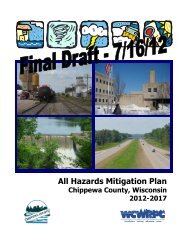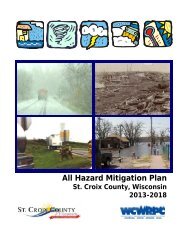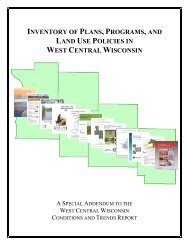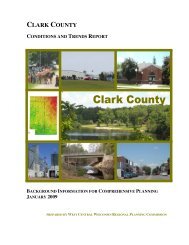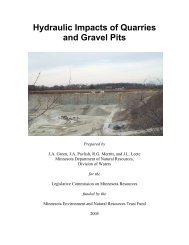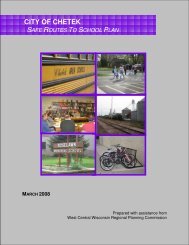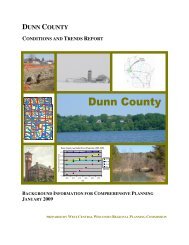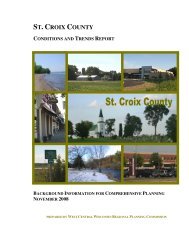BARRON COUNTY - West Central Wisconsin Regional Planning ...
BARRON COUNTY - West Central Wisconsin Regional Planning ...
BARRON COUNTY - West Central Wisconsin Regional Planning ...
Create successful ePaper yourself
Turn your PDF publications into a flip-book with our unique Google optimized e-Paper software.
Household income is the sum of money income received in the calendar year before the<br />
Decennial Census is collected by all household members 15 years old and over, including<br />
household members not related to the householder, people living alone, and other nonfamily<br />
household members. Included in the total are amounts reported separately for<br />
wage or salary income; net self-employment income; interest, dividends, or net rental or<br />
royalty income or income from estates and trusts; Social Security or Railroad Retirement<br />
income; Supplemental Security Income (SSI); public assistance or welfare payments;<br />
retirement, survivor, or disability pensions; and all other income. The median is the<br />
mathematically derived middle value with 50 percent above and 50 percent below that<br />
number.<br />
It can be seen from Table 1.21 that Barron County is average when compared to the<br />
incomes of surrounding counties. Certainly counties with, or closer to, larger urban<br />
centers have a greater “economic engine” that provides employment opportunities and<br />
resultant higher income. Those counties with lower incomes all have smaller urban<br />
centers or are further away from significant employment centers such as the Twin Cities.<br />
The data indicates that incomes for Barron County community residents are increasing<br />
faster than inflation; however, the County median household income is below that of the<br />
State of <strong>Wisconsin</strong> as a whole. It can also be seen that the median household income in<br />
12 communities is below the County median household income, including almost all<br />
cities and villages, while nine communities have median household incomes higher than<br />
that of the state as a whole.<br />
Population Projections<br />
Population projections have long been used to assess development prospects and<br />
community facility needs created by population growth. Small area population forecasts<br />
can be used to evaluate potential residential development and economic conditions, and<br />
the level of demand for public facilities and services. Businesses, schools and<br />
government frequently use these forecasts to determine the future needs or design of<br />
public facilities or services. This estimate of future growth is also valuable information<br />
for establishing management techniques to guide orderly growth and development.<br />
Projecting population is not a science in which absolutes can be placed. Consequently,<br />
there are limitations that should be remembered when reviewing and evaluating these<br />
forecasts. These limitations include:<br />
<br />
<br />
<br />
Population projections are based on historical trends of population growth that are<br />
extended into the future, and the assumption that those trends, and the factors behind<br />
them, will continue to some point in time.<br />
Forecasts of large area populations (e.g., states or counties) are more reliable. The<br />
smaller the area for which a projection is produced, like an individual community, the<br />
greater the possibility for error.<br />
The closer the projection year is to the base year; the more likely the population for<br />
that projection will be close to the true population.<br />
10 Issues and Opportunities Information



